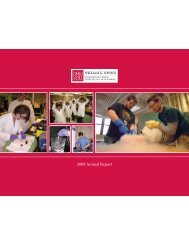ANSYS FLUENT Tutorial Guide
ANSYS FLUENT Tutorial Guide
ANSYS FLUENT Tutorial Guide
You also want an ePaper? Increase the reach of your titles
YUMPU automatically turns print PDFs into web optimized ePapers that Google loves.
Chapter 1: Introduction to Using <strong>ANSYS</strong> <strong>FLUENT</strong> in <strong>ANSYS</strong> Workbench: Fluid Flow and Heat Transfer in a<br />
Mixing Elbow<br />
1.3. Problem Description<br />
The problem to be considered is shown schematically in Figure 1.1 (p. 2). A cold fluid at 293.15 K flows<br />
into the pipe through a large inlet and mixes with a warmer fluid at 313.15 K that enters through a<br />
smaller inlet located at the elbow. The mixing elbow configuration is encountered in piping systems in<br />
power plants and process industries. It is often important to predict the flow field and temperature field<br />
in the area of the mixing region in order to properly design the junction.<br />
Note<br />
Because the geometry of the mixing elbow is symmetric, only half of the elbow needs to be<br />
modeled.<br />
Figure 1.1 Problem Specification<br />
1.4. Setup and Solution<br />
The following sections describe the setup and solution steps for this tutorial:<br />
1.4.1. Preparation<br />
1.4.2. Step 1: Creating a <strong>FLUENT</strong> Fluid Flow Analysis System in <strong>ANSYS</strong> Workbench<br />
1.4.3. Step 2: Creating the Geometry in <strong>ANSYS</strong> DesignModeler<br />
1.4.4. Step 3: Meshing the Geometry in the <strong>ANSYS</strong> Meshing Application<br />
1.4.5. Step 4: Setting Up the CFD Simulation in <strong>ANSYS</strong> <strong>FLUENT</strong><br />
1.4.6. Step 5: Displaying Results in <strong>ANSYS</strong> <strong>FLUENT</strong> and CFD-Post<br />
2<br />
Release 14.0 - © SAS IP, Inc. All rights reserved. - Contains proprietary and confidential information<br />
of <strong>ANSYS</strong>, Inc. and its subsidiaries and affiliates.









